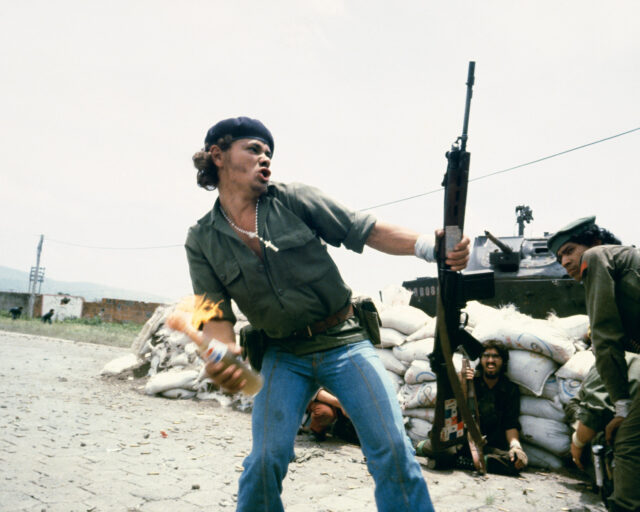Photographs Do Not Stop Wars
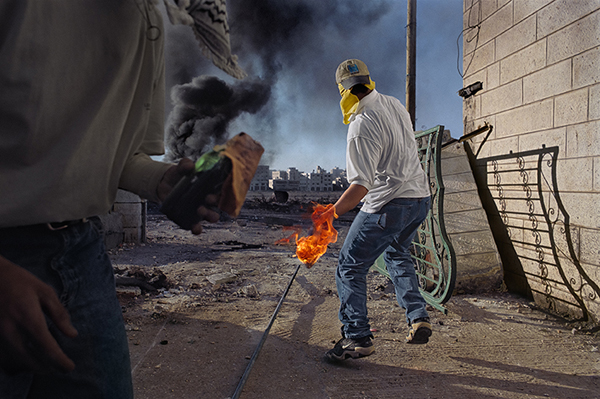
James Nachtwey, A Palestinian throws Molotov cocktails at Israeli army troops. Occupied Palestinian territories, Ramallah, West Bank, 2000
© James Nachtwey Archive, Hood Museum of Art, Dartmouth
Memoria, a large-scale retrospective at the Maison Européenne de la Photographie (MEP) in Paris, provides the occasion to review James Nachtwey’s era-defining, forty-year career. The exhibition presents 139 large, framed prints from a body of work that covers disease, war, famine, and death, from South Africa and Palestine to 9/11 and American prisons. On the heels of these riders of the apocalypse, we are led along Nachtwey’s signature-style photography: beautiful, close-to-the-bone images of immense suffering in high-contrast black and white or saturated color. One cannot help but be amazed by Nachtwey’s outlook and his sensitivity to what makes a great photograph. Yet, while Nachtwey’s astonishing oeuvre has accrued credulous praise over several decades, it’s essential to retain a critical eye and consider the chilling discrepancy between the intentions of this exhibition and the actual presentation of the work.

James Nachtwey, A bedroom becomes the frontline in a brutal civil war. Mostar, Bosnia-Herzegovina, 1993
© James Nachtwey Archive, Hood Museum of Art, Dartmouth
Nachtwey fashions himself as a witness who sets out to photograph the crises that are tearing the world apart. In Memoria, we encounter the clichés and myths often associated with war photographs: victims regain their dignity through photography; viewers cannot help but feel compassion; and, by looking at the horrors of the past, viewers will not forget what happened. The act of memory is elevated here to an inconsequential political gesture: passive remembrance, it seems, takes the place of active political engagement. However, at MEP, the actual political context is relegated to a booklet. The accompanying catalogue, consisting of images and a celebratory essay, struggles with the same lack of in-depth context. The various sections of the exhibition are announced on the wall, but besides some quotes by and on Nachtwey, the exhibition space does not provide any didactics.
This radical separation between the photographs and their context evacuates the political from images that are nothing if not political. For instance, one theme in Memoria is “Famines,” as if famine exists in and of itself and is not the result of a complex web of political and natural disasters. Upon consulting the booklet, we learn that the pictures shown under this category were taken in Sudan and Somalia between 1992 and 2004. Instead of allowing the viewer to engage with the history and politics of two distinct nations, these beautiful images are heaped on top of each other, leaving them to speak for themselves as politically powerless icons of suffering.
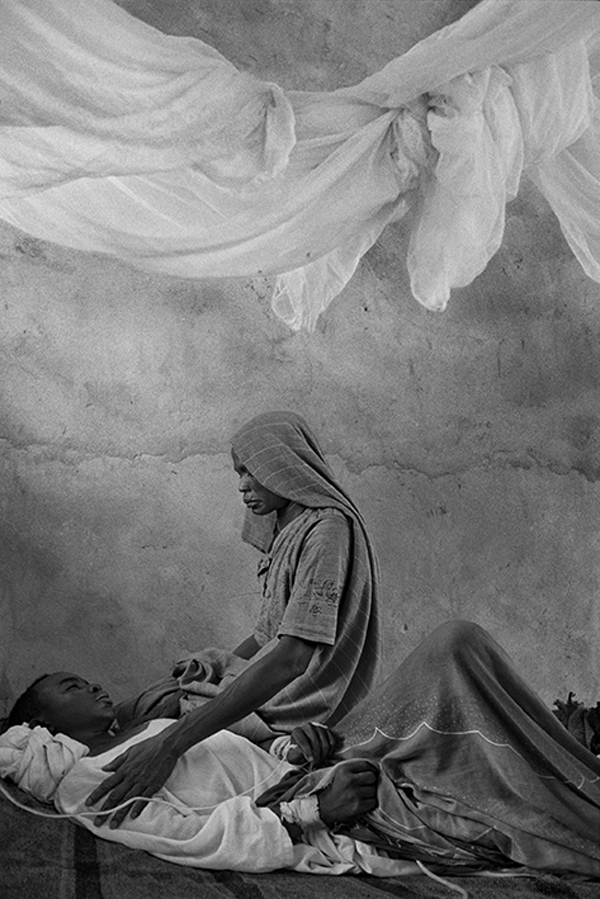
James Nachtwey, A mother stands at her child’s bedside. Darfur, Sudan, 2003
© James Nachtwey Archive, Hood Museum of Art, Dartmouth
Seeking to portray a crisis in a comprehensive way, documentary photographers must use a familiar and accessible visual language. As Memoria makes clear, Nachtwey’s language is one of iconic transcendence, of the obliteration of the individual in the search for the universal. But that universalizing power also creates a weakness: the impossibility of entering deeply into the details of a conflict. Take, for example, a heartbreaking series on the intergenerational aftereffects of Agent Orange in Vietnam from 2004 to 2012. Natchtwey’s images of parents and their disabled children beg for contextualization that is otherwise lacking throughout Memoria. The accompanying booklet provides some context, but seems to ascribe emotions and motives to those portrayed that are impossible to verify and that, to me, seem to fit too perfectly into Nachtwey’s discourse of dignity and compassion. A text in the booklet describing the Agent Orange series states that “workers and rice farmers with few resources and no available remedies have redeemed the outrage with caring and with love.” Heroic as it may sound, it seems to deny the suffering of these individuals. This is even more problematic because we are talking about the results of imperialistic warfare.
Memoria suffers from a reliance on the photographer as auteur. While in our daily media consumption, we often encounter photographs without being aware of who made them, in the exhibition space the photographer is promoted to an oracle, a mythical figure who through his experiences becomes a sage. Our understanding of documentary images is still too often determined by the terms set by photographers or their willing critics. Words become a stumbling block in understanding the work of one of the greatest war photographers the world has known. Why not heed D. H. Lawrence’s famous dictum “never trust the teller, trust the tale” for documentary photography too? By placing the photographer firmly in the exhibition’s center, and not the photograph, the possibility to understand the singularity and interconnections between the many conflicts Nachtwey covered is harmed.
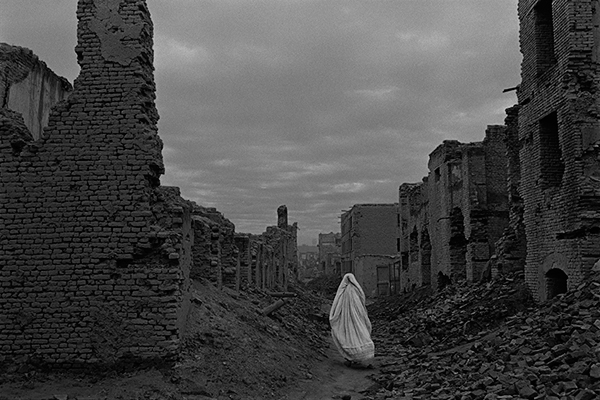
James Nachtwey, A woman wanders the ruins of the city. Kabul, Afghanistan, 1996
© James Nachtwey Archive, Hood Museum of Art, Dartmouth
Nachtwey’s work needs words, but not necessarily those of the photographer himself. A recent example that is not featured in Memoria is Nachtwey’s collaboration with Time in documenting the American opioid crisis: here abundant images are contextualized with interviews, providing an ingenious example of documentary storytelling for the twenty-first century. Other examples are Susan Meiselas’s recent exhibition at Jeu de Paume, Mediations, showing how some of her work became iconic through a complex process of international publications over the years, and how some images were used by the people they portray as a form of political empowerment—or Christoph Bangert’s book War Porn (2014), which invites the reader to investigate mechanisms of censorship and self-censorship. In both projects, the visitor or reader plays an active part, whereas in Memoria the viewer is kept at a distance, in awe in front of Nachtwey’s works. Activating the visitor by showing how these images were made, and how they became the icons they are, might have done more justice to the complexities of the production, distribution, and reception of contemporary documentary photography.
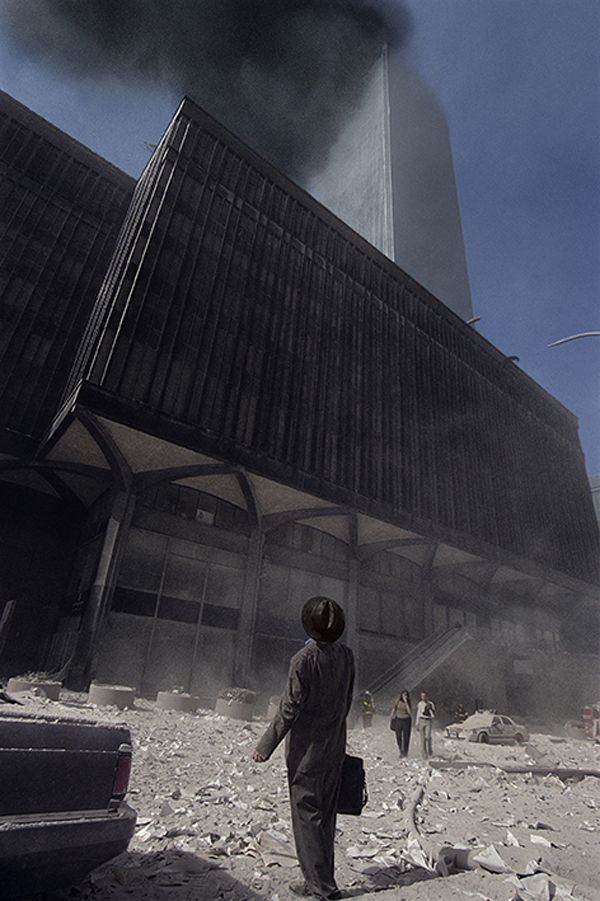
James Nachtwey, Ash, smoke, and shattered glass rained down on Lower Manhattan following the destruction of the World Trade Center. New York, 2001
© James Nachtwey Archive, Hood Museum of Art, Dartmouth
We need to accept that photographs do not stop wars from happening, and do not feed those starving to death—that our remembering past conflicts does not prevent us from waging new wars, and that, bluntly said, those whose “dignity” we celebrate in photographs could not care less for our compassion while reading a newspaper or visiting an exhibition on a Sunday afternoon. While it has been repeatedly stated that images of the Vietnam war, for instance, galvanized protest and, thereby, show that documentary photography is politically relevant, academic research has not been able to prove that images played a role in starting or furthering protest. Rather, many of the war’s most iconic images were only published when critique of the war had become common currency among intellectuals and politicians, and was no longer seen as treasonous or unpatriotic.
Our fascination with and aestheticization of suffering should not be an end in itself, but instead a starting point in attempting to understand the intricacies of worldwide conflicts and our role in them. Memoria is, in fact, a moving-away from politics, from history, and from complexity. What remains are stunning images, high points in contemporary documentary photography, but how should we contend with that when war and suffering are involved?
Memoria: Photographies de James Nachtwey is on view at Maison Européenne de la Photographie, Paris, through July 29, 2018.











